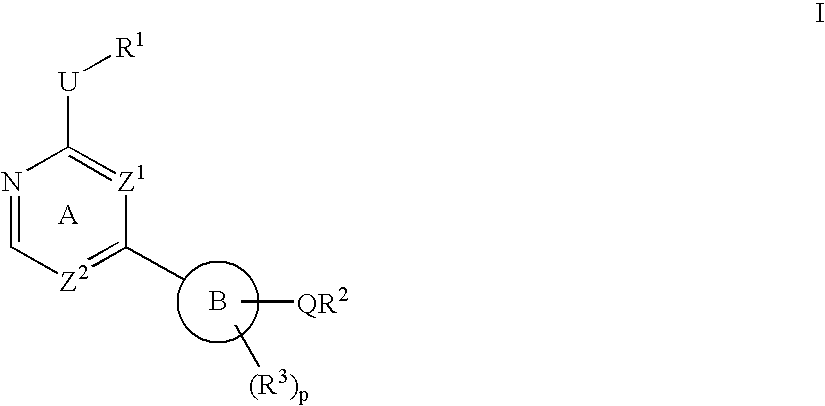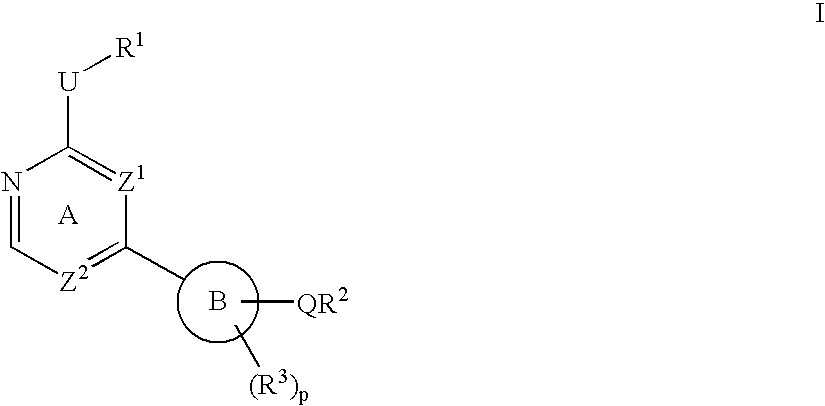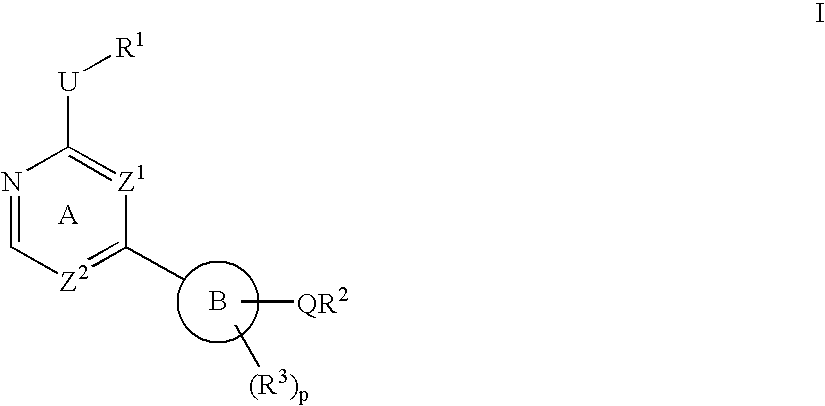Heterocyclic protein kinase inhibitors and uses thereof
a protein kinase and heterocyclic protein technology, applied in the field of medicinal chemistry, can solve the problems of abnormally high blood glucose levels, poor clinical prognosis, and failure to increase glycogen synthesis and glucose uptak
- Summary
- Abstract
- Description
- Claims
- Application Information
AI Technical Summary
Problems solved by technology
Method used
Image
Examples
example 1
[0286]1-(2,5-Dichloropyrimidin-4-yl)-azetidine-3-carboxylic acid: To a suspension of azetidine-3-carboxylic acid (56 mg, 0.55 mmol, 1 equiv.) in water (1 mL) and ethanol (0.3 mL), was added 2,4,6-trichloropyrimidine (101 mg, 0.55 mmol, 1 equivalent). The resulting mixture was heated at reflux at 99° C. for 1 hour. The reaction mixture was cooled down and the resulting precipitated solid was isolated by filtration to afford the title compound (66 mg, 49%). LC / MS: Rt=2.1 minutes; ES+247.9, ES-246.0.
example 2
[0287]1-(2,5-dichloropyrimidin-4-yl)-azetidine-3-carboxylic acid [1-(3-chlorophenyl)-2-hydroxyethyl]-amide: 1-(2,5-Dichloropyrimidin-4-yl)-azetidine-3-carboxylic acid (66 mg, 0.27 mmol, 1 equivalent) was dissolved in DMF (1 mL) together with EDCI (103 mg, 0.53 mmol, 2 equivalents), HOBt (18 mg, 0.13 mmol, 0.5 equivalent) and (S)-(+)-3-chlorophenylglycinol (67.4 mg, 0.32 mmol, 1.2 equivalents). Triethylamine (121 mg, 0.32 mmol, 1.2 equivalents) was then added and the resulting mixture was stirred at room temperature for 1 hour then warmed to 90° C. for 10 minutes. The crude reaction mixture was diluted with ethyl acetate, washed with water, and the organic fraction dried over sodium sulfate. The resulting crude oil was purified by HPLC Gilson (acetonitrile / water / 0.1% TFA), yielding the title compound as a white solid (44 mg, 41%). HPLC Rt=5.528 minutes.
example 3
[0288]1-(5-chloro-2-(2-hydroxy-1-methylethylamino)-pyrimidin-4-yl)-azetidine-3-carboxylic acid [1-(3-chlorophenyl)-2-hydroxyethyl]-amide (I-9): 1-(2,5-dichloropyrimidin-4-yl)-azetidine-3-carboxylic acid [1-(3-chlorophenyl)-2-hydroxyethyl]-amide (16 mg, 0.04 mmol, 1 equiv.) was dissolved in 1-butanol (1 mL). (S)-2-Aminopropanol (0.02 mL, 0.2 mmol, 5 equiv.) was then added and the resulting mixture was microwave irradiated (185° C., 1200 sec, high absorption). The resulting crude mixture was purified first by HPLC Gilson (acetonitrile / water / 0.1% TFA), followed by preparative-TLC on silica gel (DCM / MeOH from 95:5 to 90:10). The title compound was isolated as a white solid (3.9 mg, 21%). LC / MS: Rt=2.0 minutes; ES+454.0, ES-452.2. 1H NMR (Acetone-d6)δ 0.95 (t, 3H), 1.5 (m, 1H), 1.7 (m, 1H), 3.6 (m, 3H), 3.85 (m, 3H), 4.4 (m, 4H), 5.1 (t, 1H), 5.6 (bs, 1H), 7.25 (m, 1H), 7.3 (m ,2H), 7.4 (s, 1H), 7.7 (overlapped two s, 2H).
PUM
| Property | Measurement | Unit |
|---|---|---|
| temperature | aaaaa | aaaaa |
| period of time | aaaaa | aaaaa |
| temperature | aaaaa | aaaaa |
Abstract
Description
Claims
Application Information
 Login to View More
Login to View More - R&D
- Intellectual Property
- Life Sciences
- Materials
- Tech Scout
- Unparalleled Data Quality
- Higher Quality Content
- 60% Fewer Hallucinations
Browse by: Latest US Patents, China's latest patents, Technical Efficacy Thesaurus, Application Domain, Technology Topic, Popular Technical Reports.
© 2025 PatSnap. All rights reserved.Legal|Privacy policy|Modern Slavery Act Transparency Statement|Sitemap|About US| Contact US: help@patsnap.com



